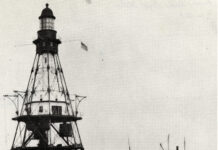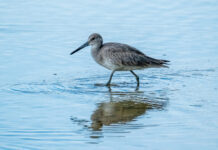
The last time I’d seen Mark Whiteside this excited was several years ago when he diagnosed me as having a botfly in my ankle. For those unfamiliar with said creatures, they are subcutaneous parasites that make use of mosquito bites to burrow under your skin and feed on your flesh for a couple weeks before crawling back out and going on to create more botflies.
Whiteside is a general practitioner but has always had a serious penchant for tropical diseases. And while this wasn’t a disease, it was a malady of sorts derived from a trip to the tropics. The gleam in his eyes was something. He had me in an office upstairs with my ankle on a surgeon’s table within 20 minutes.
I picked my botfly up in Panama. (Pro tip: don’t bird in the rainforest in flip flops.) The legless, nascent creepy crawly they cut out of my ankle was a wrinkled grayish thing about the size of a raisin. It writhed slowly and reminded me of the ceti eel that Ricardo Montalbán dropped into Commander Chekov’s ear to control his thoughts in “Star Trek II: The Wrath of Khan.” Somewhere on one of my hard drives I have a video of the botfly wriggling like it was doing a sit-up or something.
The thing Whiteside was excited about more recently wasn’t a botfly, but a butterfly. Particularly one called an Atala. It wasn’t that he hadn’t seen them before. He’d taken his family to a known spot to see a small colony of them several years ago when they were up at (if he recalls correctly) a soccer game in Fort Lauderdale. He just wasn’t ever expecting to see them here.
He’d first seen them here when he was doing the Christmas Bird Count at the end of last December with Amy Grimm, who has a similar level of butterfly enthusiasm. They were at the Key West Botanical Garden. It was pretty much all they wanted to talk about when we met for lunch that day.
I’m not anti-butterfly. I’m butterfly-curious. How can you not be intrigued by a creature that lives the first part of its life as a caterpillar, seals itself up into a cocoon, turns itself into mush, and then comes out a couple weeks later as a fully formed flying butterfly? But I haven’t crossed over into butterfly mania the way Whiteside and Grimm have.
I blame my brain, which I generally view as ungovernable. Me telling it to remember or learn something rarely results in me remembering or learning something. Not that it doesn’t remember or learn. It just doesn’t take instruction. It remembers and learns what it damn well pleases.
People’s names? Directions announced by the GPS 20 seconds ago? The entire Spanish language (outside of my Sandy’s or El Siboney orders)? Can’t remember any of it. The fact that the getaway driver in the movie “Ronin” was played by an actor named Skip Sudduth? That kangaroos have three vaginas? That Elvis Costello’s real name is Declan McManus? That info is right there, front and center.
I’ve tried to get methodical with butterflies, but methodical never works for me. They’ve never been as revelatory or vital for me as birds. I haven’t given up hope that the spark will light, I’ve just gotten somewhat zen about it. “Que Sera, Sera,” as Sly Stone once sang.
But Whiteside kept texting me about the Atalas and finally, when I had a free Saturday, I met him at the botanical garden.
It’s unclear when Atalas were last seen in the Keys. Its host is coontie, one of the more ancient plants in the world, a low, green, fern-like plant with stiff, skinny leaves. It’s where they lay their eggs, what they feed on as caterpillars and where they attach their chrysalis.
Native Americans and early settlers would dig up the plants and ground their roots for use as a flour-like substance, though they had to do it carefully as the plants are full of toxins and poisonous if not prepared properly. There was more industrial production in the late 1800s and early 1900s, up until World War I. In more modern times, the hardy, drought-tolerant plant became a victim of its own popularity, as it was pulled out of native habitat to use in landscaping products.
As a result, for a while, it was thought that the Atala butterfly had gone extinct in the U.S. None were seen in Florida, the only state in their range, between 1937 and 1959. But then some small colonies were found in Broward and Miami-Dade counties. (The species is also found in Cuba, the Bahamas, the Caimans and Turks and Caicos.)
Wild coontie is now legally protected, and the coontie used for landscaping tends to come from nurseries. But a lot of it has been replanted in the now more-urbanized Florida neighborhoods. The species is still rare, but it can be readily found in certain parts of south Florida.
While nobody knows when Atalas were last seen in the Keys, it seems unlikely they were seen by anybody living. So finding them at the botanical garden is a pretty big deal.
Whiteside isn’t sure how they got here, but he has theories. Some butterflies do migrate (see: monarchs) but Atalas are homebodies and rather slow fliers. They don’t tend to stray very far from where they were hatched, so it’s unlikely they came from Cuba or the Bahamas. Most likely they came from Broward or Miami-Dade with some nursery-raised coontie.
When I met him in the botanical garden parking lot, we only had to walk to the edge of the sidewalk before seeing the first one. Perched, with its wings folded, it was a small, onyx black wedge, about the size and shape of a guitar pick, with three rows of irregularly shaped iridescent zircon blue spots on the outer edges of the wing, a large lava red oval on the low edge of the wing, and a matching lava red abdomen. When it flew, it was just kind of a blur.
We followed the row of coontie that dotted the edge of the path. As we walked we saw more and more of them – groups of three, groups of five. Whiteside stopped at one plant to pull back the leaves to show me a chrysalis. He stopped at another to show me a caterpillar.
We passed the chapel and made our way into the grassy open area and to the shortleaf fig at its edge. We could see a couple Atalas flying, and then, dozens of them perched on the leaves and branches. Forty of them, 50 of them. The longer we stood there, the more we spotted.
“It’s an Atala wonderland,” Mark finally said. “You couldn’t ask for a more successful introduction, however they got here.”
























